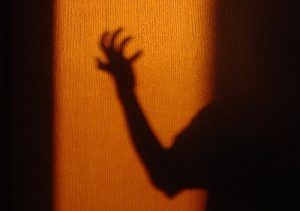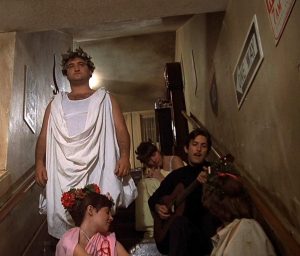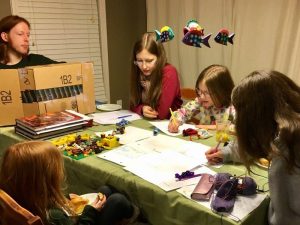Posts by Jo Eberhardt
A couple of months ago, I took my children to see the new Lego Ninjago movie at the cinema. For those people unfamiliar with the movie (like, perhaps, most people who don’t have a child under the age of 12), the plot revolves around five trainee-ninja teenagers who must learn the ways of Spinjitsu and defeat the evil Lord Garmadon. The movie opens with our heroes foiling Lord Garmadon’s attack against the city of Ninjago by piloting giant elemental-themed mechs.
There’s action and adventure and ninjas—the trifecta for my sons—and all was going well. Then, just as they easily win the battle, one of the heroes exclaims, “As long as we have these mechs, we’re unstoppable!”
It was at that moment that my ten-year-old son leaned over to me and said, “That means they’re going to lose their mechs, and have to beat Garmadon without them.”
What I said was, “Let’s keep watching and see.”
What I thought was, “Yep. We may as well leave now. We already know how the story will play out. That’s the most heavy-handed foreshadowing I’ve ever seen.”
[SPOILER ALERT: The heroes lose their mechs, and have to beat Garmadon without them.]
Later that night, I was watching some particularly good stand-up comedy. As the set drew to a close, and I was laughing much more loudly than I probably should have been while my children were asleep in the next room, I found myself thinking about the art of the callback. That, in turn, led me to wonder about the relationship between foreshadowing and call-backs.
Are they related?
One sets up future events, and the other references past events, sure. But does that mean they’re linked?
Read MoreIt’s that time of year again. The airwaves are full of ads for weight-loss programs; gyms are offering discounted annual memberships; and self-help books are flying off the shelves.
Me? I’m not a huge fan of New Year’s resolutions. I’ve never really understood the desire to spend the last night of the year making solemn promises–drink in hand–to get fit, or stop eating cheese, or to commit to whatever life-changing idea occurred to me during the last couple of weeks of the year.
I am, however, a fan of goal setting. I like to create a list of goals that I intend to achieve during the year, in various areas of my life.
When it comes to writing, I like to make SMART goals. That is, goals that are:
Goodbye 2017
Read MoreA couple of weeks ago, a friend sent me a message about a book he’d just finished reading. “This book was terrible,” he said. “It was an urban fantasy novel, and the story was good, but the protagonist was just awful. The author’s name was female, but it was clearly written by a man. No woman would ever talk about themselves like that.”
“Like what?” I asked.
His complaint was that the female protagonist called herself a bitch on every other page, referred to herself as a slut a couple of dozen times throughout the book, and regularly described and critiqued her breasts and… ahem… more private areas. Despite the magic, mystery, and action that should have been the focus of the story, the protagonist spent more time objectifying herself than actually engaging with the plot.
For my friend, the lowest moment came after the protagonist had a one-night-stand with a male love interest. While the man was still asleep in bed the next morning, the protagonist sneaked off to the shower and harangued herself: “Why am I always such a dumb slut when I’m drunk?”
As it turns out, my friend was wrong: the author is a woman. Plus, of course, in real life, women–especially young women–talk about themselves like that quite frequently. “You’re a 40-something man,” I said. “You’re not really the author’s target audience.”
But then I got to thinking. Who is the target audience for this book? And how does it affect them?
Read MoreIf you ask a small child to draw a tree, they will almost inevitably draw a brown rectangle topped by a cloud-shaped green blob. That’s what a tree looks like. We all know that. We recognise it instantly for what it is.
Even children too young to draw the shapes will scribble a brown trunk with a green top. We can look at that mess of scribbles and say, “Oh, what a beautiful tree you’ve drawn.”
But as adults, we know that very few trees actually look like that. There are oak trees and pine trees and palm trees; trees that are good for climbing, and trees with long, thin trunks that reach into the sky; trees with leaves that turn golden in the autumn, and trees that turn purple in the spring; trees with a bounty of mouth-watering fruit, trees covered in sweet-smelling flowers, and trees that will puncture you with their thorns if you dare get too close.
Even among individual species of trees, there are wide variations. The soil, the weather, the sunlight–the environment in which a tree grows–will change the shape, size, and health of any given tree. And let’s not even get started on seasonal variations. A tree in spring often looks significantly different to the same tree in winter.
In short, if you went through life thinking that all trees looked like brown rectangles with cloud-shaped green blobs on top, you’d spend a lot of time wondering what all those other tall, fruit- and flower-coated growing things were.
And yet I’d be willing to bet that if you asked most adults to draw a tree, their picture would like something like this:
And that’s perfectly okay–we, as experienced humans, know that the image isn’t accurate. But it’s a helpful visual shorthand. And one that I, as someone who struggles to draw even stick figures, am incredibly grateful to be able to embrace.
It’s only problematic if an expert–someone who makes their living teaching people about trees–claims that this is what all trees look like. Or, in fact, if they claim this is what any normal tree looks like year-round.
People are not trees
Nonetheless, there are specific images we tend to draw on when we think about people; particularly when we think about people of a gender different to our own.
There’s the “alpha male” who likes sports and cars and telling people what to do.
There’s the “princess” who likes flowery, floaty pink things and needs to be rescued from difficult tasks like running in a straight line.
There’s the “badass” who plays by his own rules and has a witty quip for every situation.
There’s the “strong female character” who wears combat boots and is too busy kicking butt to both take names, but suddenly forgets everything when the hero turns up.
I could go on. But you get the picture.
All of these characters are exactly as accurate to real life people as that scrawled brown and green image is to a real tree.
If you want to write authentic, accurate, interesting characters of either gender, that’s really all you need to know. People are not stereotypes. People are fully developed individuals, a product […]
Read MorePhoto by Thomas Wolter
My original intention this month was to write about some of the common challenges people have when writing across gender lines—that is, male writers writing female characters and female writers writing male characters. For some people, this comes quite naturally. For others, it seems an almost impossible task—particularly when the character in question is the protagonist.
However, when I started to put together this article, I realised that there is another topic to be tackled first—and that is the stereotyping of female characters as a whole. Rather than try to say everything I wanted to say in a single post, for this month I’m going to concentrate specifically on writing female characters without devolving into ridiculous stereotypes.
Save the Day Like a Girl
The phrase “like a girl” is one that has had negative connotations for a long time. I remember it being the insult of choice back when I was young enough to count my age in single digits–and, according to my children, dinosaurs roamed the Earth back then.
Some of the discussion in the comments of my last post veered in exactly this direction, and reminded me of the ad campaign #LikeaGirl from a few years ago. You’ve probably seen this video at least once over the last three years.
https://www.youtube.com/watch?v=XjJQBjWYDTs
In one of the other videos from this ad campaign, a young girl specifically says: “It’s always, like, the boys who rescue the girls in the stories.”
This is the world that most of us have grown up in–a world where “like a girl” is an insult, implying a lack of skill, knowledge, or competence; where “running like a girl” means worrying about your hair, flinging your hands around ineffectively, and probably tripping over and spraining your ankle; where male protagonists were considered the “default” setting. The idea is still out there that books about girls are for girls, but books about boys are for everyone, especially in children’s fiction.
And while there are genres where female protagonists are common, those genres are often seen as being written primarily for women.
There are a lot of writers stepping up and changing that situation. But there are just as many who still find it hard to envision a female protagonist who is just as competent, brave, and heroic as her male counterpart–at least, without also worrying that she’s too “manly”.
Be Heroic Like a Girl
For whatever reason, I’ve often found that the people who struggle the most with writing strong, competent, fully developed female protagonists are female writers.
Much like in the video above, we’ve internalised the idea that women are incompetent when it comes to physical activity (and maths), and can be even more guilty of playing down the strengths of our female characters than many male writers. I freely admit that there was a time in my youth (possibly around the point when dinosaurs went extinct) when I wouldn’t even consider writing a female protagonist because I knew it would be lame.
How could a female hero possibly save the day when she was bound to sprain her ankle or break a fingernail along the way?
Obviously, that’s ridiculous. I’m a woman, and I’ve never once tripped over nothing and sprained […]
Read MoreIt’s recently been announced that there is a new adaptation of William Golding’s classic novel Lord of the Flies in the works. This isn’t a huge surprise. In the modern era of remakes, re-imaginings, and even more remakes (I’m looking at you, Spider-Man), it feels like half of the new Hollywood movies released aren’t so much “new” as repurposed. Besides, the most recent film adaptation of Lord of the Flies was all the way back in 1990. That’s basically the dark ages. (At least, it is if you ask my children.)
This announcement has been met with a whole passel of outrage from every corner of the internet. Why?
Because apparently Lord of the Flies is due for a gender-swap, with this movie to include an all-female cast.
Yes, the classic tale of young English boys who revert to primal savagery when they’re stranded on a tropical island is currently being rewritten into the tale of a group of young English girls who, we can only assume, revert to primal savagery when they’re stranded on a tropical island. Never mind that this novel is taught in high schools around the world as a way of exploring the destructiveness of competitive masculinity and machismo–it’s clearly the right time for movie-goers everywhere to watch the sweet, spiritual Simone burn to death in the middle of a ritual of competitive femininity. Whatever that looks like.
Read MoreA couple of days ago, Gabriela Pereira wrote an amazing article detailing a more entrepreneurial approach to an MFA. (If you missed it, I highly recommend you go back and read it now. I’ll wait.)
Gabriela’s third point was about community, where she made the point that “the four components of a writer’s circle of trust are critique, accountability, support, and advice.”
I read that sentence and my reaction was an exuberant: YES!
The Circle of Trust
Gabriela went on to explain that although many writers think about critique partners when they talk about their writing careers, the other parts of the writing circle are equally as important. Unfortunately, she didn’t expound on specifically what she meant by the component of ‘support’–or, perhaps, fortunately, as that’s the element I’d like to talk about today.
Support, to me, is about encouragement. I’ve written about the importance of encouragement before, but I really feel that it can’t be overstated. And so I’d like to share a brief story about the first person who really encouraged me in my writing career.
Encouraged for the Very First Time
I had an exceptional English teacher in tenth grade. He was a big proponent of teaching creative writing, and would shoehorn it in between spelling tests and literary criticism at every opportunity. Towards the end of the year, he had every person in the class write an opening sentence on a piece of paper. Those pieces of paper were put in a hat, and we each drew one randomly. We had one day to write a 500 word short story starting with our randomly-selected opening line.
I drew an opening line written by one of the stoners in the class—an uncomfortably detailed first-person description of waking up and needing to vomit. (Which may well have been how the student in question was feeling at the time, considering his earlier preoccupation with making himself dizzy by watching the fan spin overhead.) There was absolutely nothing about the opening line that appealed to me. I put off writing my story as long as I possible. Finally, at 11pm that night, I turned on my C64 computer, loaded up a word processing program, and started to write.
I finished at 5am. My story was just over 5000 words long, and I knew it was brilliant. (Disclaimer: I was 15. It probably wasn’t.) I wrote about a man who woke up in hospital (vomiting due to a reaction to the anaesthetic) and found himself in the wrong body—a female one. He’d been in an accident, and had needed a full-body transplant. The only body available belonged to a fifteen-year-old girl whose mother had sold her body (literally) in order to get enough money for the rest of their family to survive comfortably. The story dealt with sexism, poverty, and a whole range of other ideas that I couldn’t have even put into words at that age.
When I got my story back from my teacher it was covered with exclamation marks and ticks–with a giant A+ on the top of the first page in scarlet ink, along with a note suggesting that I consider a career as a writer.
When Gabriela mentioned ‘support’, those hastily scrawled words from my teacher […]
Read MoreKevin Spacey as Frank Underwood
One of the questions that often plagues writers is: Is my protagonist likeable enough?
At some point in our writing career, we’ve no doubt been told that our protagonist should be someone readers want to spend time with–someone they’re happy to commit to hanging out with for 300+ pages; someone they will care about; someone they will want to triumph. And yet, there are plenty of great books out there with protagonists who are not just unlikeable, but actively unpleasant. From Humbert Humbert to Amy Dunne, literature is littered with protagonists we love to hate.
Over the last few weeks, I’ve found myself dwelling on why unlikeable characters can be so engaging. Why? Because I’ve been watching Netflix’s House of Cards.
House of Cards is an American political drama loosely based on a British mini-series of the same name, which was, in turn, based on a book by Michael Dobbs, set in post-Thatcher UK. As Dobbs wrote in 2014: “The US series is different, of course, but not that different than the book that started it all. It’s true to the spirit of the story I wrote so many years ago—a dark tale of greed, corruption and unquenchable ambition.”
The protagonist of House of Cards is one Francis “Frank” Underwood–a ruthless politician who will stop at nothing to achieve power. And when I say “nothing”, I’m not exaggerating. He is, by far, the most unlikeable protagonist I’ve ever watched. And yet I can’t stop watching him.
Some of that is undoubtedly the hope that he will one day get his comeuppance… although I’m not counting on it happening any time soon. But as I watched yet another episode where I found myself wavering between feeling uneasy and nauseated by Underwood’s actions, I asked myself: What is it about Underwood that keep me completely engaged in his story, even as I like him less and less?
Read MoreAs I’ve been working through revision on my manuscript, I’ve been thinking a lot about sub-plots. Do I have enough? Too many? Do they work? Do they serve the story?
In working through the sub-plots in my own manuscript, and comparing them to sub-plots in some of my favourite books, I’ve come to the conclusion that there are three main types of sub-plots:
If I’ve missed any, feel free to tell me in the comments. These three, however, serve as a great starting point to determine whether a particular sub-plot serves the story, or whether it’s nothing but filler.
Character Sub-Plots
The purpose of a character sub-plot is to reveal additional information about a major character. Perhaps you’d like to show a different side of a character, or reveal information about their character that is pertinent to the actions they take during the course of the main plot. These sub-plots are the ones that turn the character from what I affectionately call a “character sheet with a gun” (often used amongst my circle of RPG-playing friends to describe a poorly created character) into a well-developed, multi-faceted person.
Let’s say, for example, you have a protagonist who is a hired assassin. He’s hired by an unidentified man to kill someone, but the job goes horribly wrong when it turns out the target is actually a vampire (because, why not?) and he shrugs off the bullet and swears vengeance on the hitman. The protagonist spends the rest of the story alternately fleeing from an angry vampire and trying to find out who hired him and why. In the end, he has to choose between cutting off the vampire’s head (thus completing his job) or letting the vampire live, and…. I don’t know, handing over the person responsible who hired him, or taking a contract on his previous employer, or simply checking himself into a psychiatric hospital in the hopes that the monsters won’t get him.
The point is that, during the course of that plot, we only see one side of the character — and in this case, he really is a “character-sheet with a gun”. Now, that’s all well and good if you’re writing a summer blockbuster where explosions and witty quips are (seemingly) more important than character development, but what if you want to show another side of the action hero?
Perhaps there’s a sub-plot where he promises his niece he’ll take her to her dance recital, but then he can’t make it because a vicious vampire followed him home. The sub-plot where he desperately tries to make it up to his niece, showing up backstage to her final performance, is completely unrelated to the main plotline, but it reveals a lot about who the protagonist is, deep down. And that’s going to make your story stronger.
Intersectional Sub-Plots
Read MoreIt’s become something of an adage that every literary agent (or publisher, or editor, or reader…) is looking for is a fresh and distinctive Voice. But what, exactly, is Voice?
Depending on where you look, you’ll find any number of people offering definitions, ranging from Rachelle Gardner:
Your writer’s voice is the expression of YOU on the page.
To Leah McLellan:
Your personality comes out in your writing. Your voice is a combination of your attitude, your tone, and your personal style.
Or Darcy Pattison:
Voice is something subconscious that appears as a result of style; that is, a consideration of vocabulary, sentences, punctuation, rhythms, and formality.
None of those definitions are wrong, but nor do they really nail the description. Perhaps, like pornography, a distinctive Voice is hard to define, you just know it when you see (hear?) it.
I’m not the first person on Writer Unboxed to talk about Voice, and I will definitely not be the last. There are fantastic essays here on the site by Meg Rosoff, Mike Swift, and Donald Maass, amongst others. And I’m not going to attempt to define the indefinable. Instead, I want to talk about one specific aspect of Voice:
Perspective.
Read MoreWhen we were children, our every activity was guided by the hedonistic pursuit of pleasure. We felt fulfilled after a day spent colouring outside the lines, jumping over carpet-lava, and spinning in circles until we were dizzy and giggling. When we were forced to do something we didn’t like, we’d cry and scream as though putting on clean clothes was an internationally-condemned form of torture, then we’d go back to following our bliss—maybe by building elaborate space-ninja-pirate-castle-ships, or maybe by emptying the contents of the cutlery drawer all over the floor.
Then we grew up.
The first time we sat at a desk and complained that we didn’t want to do our homework, we were told that work isn’t supposed to be fun, but we have to do it anyway. The pursuit of happiness was relegated to weekends and vacations.
We heard it over and over. Work isn’t supposed to be fun. Fun is for children and hobbies.
But that was okay, because we had a hobby we loved: writing.
We slaved away at our unsatisfying jobs, content in the knowledge that when we’d finished, we could relax into the effervescent enjoyment of making up imaginary worlds. Writing was an escape and a pleasure—more akin to those early days of spinning in circles until we were dizzy than actual work.
Then everything changed.
At some point we realised that writing with the intention of publication was nothing short of W-O-R-K work. That old training reared its ugly head. Work isn’t supposed to be fun. Suddenly, it was much harder to approach writing with the same joie de vivre that we once had, because, as we all know, work is supposed to be brain-numbingly dull.
But we worked hard. We learned about voice and tension and the “evil” of adverbs. We joined writing groups, and reading groups, and devoted ourselves to reading books and blogs. We studied great works of literature, and modern breakthrough novels. Then we returned to our own writing and realised the unalienable truth:
Compared to our heroes, our writing is mediocre at best.
Perhaps we considered quitting. Perhaps we even did quit for a while. But eventually, we came back to writing. We couldn’t help it. We massaged our prose, trying to make it as perfect as it could possibly be. We reminded ourselves that work is supposed to be hard. Work isn’t supposed to be fun.
Read MoreI must not fear.
Fear is the mind-killer.
Fear is the little-death that brings total obliteration.
— Frank Herbert, Dune
Fear is not unique to writers, but we do seem to spend a lot of time dwelling in its kingdom. Sometimes I think the only thing I spend more time doing than being afraid of some element of writing is trying not to be afraid. It’s a little bit insane.
Let’s talk about fear.
Fear is not the enemy. It doesn’t exist to stop you achieving greatness; it exists to make you consider whether your intended actions will lead to greatness or despair. Will jumping off a cliff make you a daredevil, or a particularly unappetising pancake? Fear is that little voice that stands with you at the edge of the precipice and says: “Are you sure this is a good idea?”
And yet much of our culture is based on the precept that fear is bad. The only thing worse in our society than being afraid is telling people that you’re afraid. People are literally afraid of being perceived as being afraid. This particularly applies to men, incidentally, who are conditioned by society to believe that admitting to emotions of any kind–particular fear–equates to “weakness”, but it’s true of anyone who prides themselves on their objectivity and rationality.
Is it just me, or is that a little messed up?
Fear is anxiety caused by the anticipation of an imagined future event or experience. It’s the answer to “what if”, when imagined by a pessimist. Or a novelist—after all, isn’t imagining “what if” and then “making it worse” essentially the job description of a writer?
Writers’ fear tends to manifest in one of a few ways.
Fear of Failure
Read MoreI spend far too much time on the internet. Not (just) reading political stories which occasionally make me feel frustrated and/or helpless, either. No, I also spend far too much time in forums and writing groups and the like, which also occasionally make me feel frustrated and/or helpless. So I’d like to take a moment to address a question/problem that I see posed far too often. It goes something like this:
My son/daughter/partner/friend/mother/cat wants to be a writer, but they’re no good at it. How do I tell them that their writing is terrible and they should find a different career?
Now, I’ve heard this question in meat-space as well, at writing groups (or about members of writing groups), and in general conversation — often roughly 3.5 seconds after telling someone I’m a writer. I’ve also heard/read some absolutely atrocious answers. But I very rarely see the simple, two word answer that is most fitting:
You don’t.
Here’s the thing about writing: No one is good at it when they start out.
Let me tell you about the first novel I wrote. It was an epic fantasy saga, set in a world bereft of geographical, political, or social logic. The protagonist was a young man who was chosen by an ancient prophecy to save the world from poorly-defined evil through the tried-and-true method of finding a magical sword, gathering companions (one wizard, one thief with a heart of gold, one grizzled soldier, one paladin, and one token female who started out — obviously — disguised as a boy), and journeying across the incongruous landscape to take part in an epic battle. An epic battle that was fought and won in a single afternoon. Then, of course, the Chosen One got the girl, refused to take the treasure for himself, and was lauded by everyone in the world as a Hero of Epic Proportions.
I’m pretty sure I managed to shoehorn a few more tropes in there, but I’m too embarrassed to elaborate further.
That novel was named “Dark Forest”, and I was absolutely, positively convinced that it was going to be a bestseller to rival Tolkien.
Spoiler alert: It wasn’t. It now lives in an abandoned folder on my computer, a poignant reminder of how far I’ve come.
As if the hackneyed plot and character-free characters wasn’t bad enough, my actual prose was…. Well, let’s just say that if a sentence could possibly include an adverb, it had at least seven shoved in there. And no dialogue was complete unless it was shouted, whimpered, pleaded, murmured, or spat. Adverbily.
Read More





















